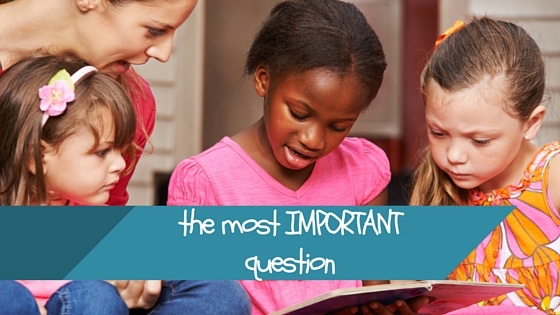
Bloom and his Taxonomy gave me a guilt trip.
Can I get a witness?
Like many teachers-in-training, I was taught the cognitive domain of his hierarchy of questions: knowledge, comprehension, application, analysis, evaluation, and synthesis.
Hierarchy. Bah! That’s so…
so……
so…
…..hierarchical.
Whether it’s a whole-class read-aloud or a 1-on-1 conference with a book, I’m always second-guessing my questions for reading comprehension.
That’s just a literal question, Marnie.
That’s simply seeking after basic knowledge—I’m not asking her to think!
Start with a “why” or “how” question, for pity’s sake.
And then! Enter the self-reproach that comes from not asking enough text-to-world or text-to-text questions.
Why is every question always about their lives only?
How can I prompt them to see the connections to their world about this?
I'm not asking the right question!
Thus endeth today’s rant. 😉
Hang with me.
[A note from our lawyer: This ranting is merely illustrative for the purposes of humor and getting you to continue reading to the important educational point we want to make. Please do not assume that we think that Bloom’s taxonomy or making a variety of connections with texts are bad. This is a joke.]
What Is the Most Important Question?
Hyperbole aside, a teacher wields incredible power with her questions.

Indeed.
The difference between a student’s learning or not. The difference between her insight into the child’s area of need or not.
Yet, when I struggle with teaching a struggling reader how to comprehend on his own, I have gotten bogged down by the bewildering number of question-types I could ask. After much trial-and-error and considerable reading of the research on comprehension, I distilled the possibilities down to 1 question.
Just 1, you ask?
Summarize, Summarize, Summarize.
Yes, for preK-2 readers or for anyone still struggling with reading, the most important comprehension question is simply, “What was this text about?”
Or, try any variation on that theme:
- What’s the main idea?
- What’s the gist?
- What’s the main thing the author wants you to learn?
- In 1-2 sentences, tell someone who hasn’t read this, what it was about.
- As briefly as possible, describe what you learned.
Teasing aside, Bloom aptly noted that the foundation for learning rests on knowledge and comprehension. Think about what the word “foundation” means? Imagine buying what you thought was your dream home only to discover cracks and weaknesses marring the foundation?

Yikes!
So it is with learning to read.
Fill in the foundation’s concrete smoothly and completely by helping the developing reader to know that her first order of business when encountering any text is to summarize in her own way.
Analysis and evaluation or text-to-world connections will come later. And we can ask them along the way, for sure!
Yet, if we don’t ceaselessly pursue her meta-cognitive ability to retell, summarize, state the gist, or whatever you like to name “summarization,” she will not develop into a strong reader.
Nor will she develop into a strong learner.
Besides rapid recognition of words, a second hallmark of a good reader is the awareness of his own ongoing comprehension of what he is reading, as he is reading it.
He assesses his comprehension by considering if he can create an running image or dialogue in his mind of the fiction text’s main action or the informational text’s main lessons. This work of thinking and continuously summarizing is the main, the primary, the foundational work of reading, and, frankly, of learning.
Please don’t get me wrong.
We should ask deep questions.
We should help students connect their experiences and their reading lives with the book at hand. At the intersection of a good text and the human mind lie profound possibilities.
However, if a student doesn’t demonstrate the ability to summarize either fiction or informational text, then one of our ultimate responsibilities is to first guide him to:
- summarize fiction and informational text, and
- be aware of when he is or isn’t comprehending so he can re-direct his efforts (this is what meta-cognition does for him).
Build Upon the Foundation of Comprehension
The Most Important Question–or “What is this text about?”–is a matter of relative priorities. It's a matter of preeminence among multiple, competing standards.
Here at Reading Simplified we strive to cut through the clutter of standards, expected outcomes, objectives, guidelines, chapter goals, suggested activities, Pinterest wonders, etc., etc. We want teachers to see clearly a streamlined path towards cultivating successful readers and learners under their wings.
That's why it's important to remember that not all standards or objectives are created equal.
For instance, there are 10 Literature Common Core State Standards for the first grade teacher to teach towards.
Which of the following two has a greater importance?
CCSS.ELA-LITERACY.RL.1.2
Retell stories, including key details, and demonstrate understanding of their central message or lesson.
CCSS.ELA-LITERACY.RL.1.6
Identify who is telling the story at various points in a text.
While both are good, only standard 1.2 represents the core work of reading comprehension.
Indeed, this standard of retell and showing understanding should make up the bulk of the first grade classroom. So, don't let the press of the many (standards) press out our focus on the essential (retelling or summarizing).
This is probably making intuitive sense to you.
Want to know more about the research?
Briefly: Others in the research world have similarly highlighted the benefits of summarizing. The National Reading Panel demonstrated that summarization was one of 7 strategies deemed effective. In addition, Robert Marzano's broad brushstroke meta-analysis of instructional strategies reduced the possibilities to just 9 strategies most likely to create positive impacts: Summarizing was one of those 9. Finally, here's what Tim Shanahan, a researcher and past president of the International Literacy Association, says about the relative value of comprehension strategies here:
Strategies are not all equal. There is a greater payoff to some strategies than to others, so I would definitely put my instructional nickel on the ones with the big learning outcomes. The most powerful strategies by far are summarization (stopping throughout a text to sum up) and questioning (asking and answering your own questions about the text). The weakest: teaching students to think about how to respond to different question types (effect sizes so small that I wouldn’t waste my time).
Images, input, and information bombard young children today. Imagine with me an intrepid young reader learning how to think as she reads. She reads a little, hears a noise, bites a nail, looks at the picture, reads a little more, remembers what happened on The Voice last night, sings a tune from the car ride silently in her head, and then reads a little more.
All of that incoming information must be organized and stored, if understanding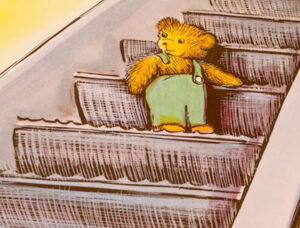 is to happen. If the teacher asks her, “Why is Corduroy going up the elevator?” Our young reader may be able to pull that slice of information out of the jumble in her head. However, that does not ensure that she can provide a coherent summary of the plot basics.
is to happen. If the teacher asks her, “Why is Corduroy going up the elevator?” Our young reader may be able to pull that slice of information out of the jumble in her head. However, that does not ensure that she can provide a coherent summary of the plot basics.
I have seen this countless times, especially with young readers, those with limited experiences with texts, or those with language processing challenges. Some kids can understand the bits of a text but cannot re-create the whole.
Teachers who haven't ensured that every student can independently create a summary of a grade level text may be missing informal assessment opportunities by not leading with The Most Important Question. They may unwittingly be making assumptions and trying just for the “more advanced objectives,” all the while the foundation for comprehension hasn't been laid.
That's why it's essential to always remember The Most Important Question when discussing a text with students.
In fact, I would like 100% of my students to know that they will first summarize a new text before they ever move onto another question or activity. Every day. Every text. (Even if the summary is in their heads only.)
How does this work day-to-day?
During guided reading, a teacher might keep assessment notes on which of her students can summarize well. If Dino and Emily can't, then every day, the teacher coaches them through a summarizing opportunity until they have mastered The Most Important Question. The other students will also have opportunities to summarize and they will also receive more opportunities for more open-ended questions a la Bloom.
Or, for whole-class read aloud, a teacher might target Dino and Emily especially with the, “What's happened so far?” question. If they volunteer for any other question type, great! But she will likely hold that diagnostic challenge in her head as a foundational instructional goal until both Emily and Dino achieve it.
Emphasizing just 1 question at first may now sound good to you but, if you are like me, you also may be squirming in your chair because you are beginning to remember how challenging it is to teach someone how to summarize if he doesn’t already know how to do it.
Have you been here?…..
Teacher: Who can briefly tell me what Courderoy is about? Pretend you are telling your mom about the book today when you get home.
Happy 1st Grader waving his hand: A teddy bear!
Teacher: Yes, the main character of the book is a teddy bear, Corduroy. What happens to Corduroy?
Same Happy child: A lost button!
(Getting weary) Teacher: Yes, Corduroy loses his button one day. But think about the whole story from the beginning (pointing to the first few pages) to the end (flipping to back and showing pictures). What problem does Corduroy have and how does it get solved?
Happy child, more tentatively: He loses his button. He pulls on the bed's button.
And so it goes…if the teacher wants to persist with this child.
Or, how often do we revert to this:
Teacher: Sarah, can you please tell the class what Corduroy is about?
Sometimes this is the best response (sans the attitude) given the variables we are juggling in our class. Often, though, it is a short-cut that misses a critical opportunity to teach how to answer the Most Important Question.
Why do we take the short-cut?
I think we avoid The Most Important Question because coaching a student on the mental gymnastics needed to summarize (if he hasn’t already learned the skill) is VERY HARD.
Yes, I’ll admit I sometimes avoid it!
We avoid the interaction because we’re not sure we can effectively guide the child to begin to summarize.
“How hypocritical!” you’re thinking?
“You’re just replacing my Bloom’s taxonomy guilt with a new one!”
Yikes!
I hope the following general strategy will relieve any anxiety. This set of steps has served us well for young children as well and adolescents whose foundations have been neglected.
How to Prompt for a Fiction Text’s Summary
The Main Idea?
Ask, “In 1 to 3 sentences, please tell me what happened in this story.”
(Ideally, for students who can't yet answer The Most Important Question, prepare in advance with a story with a simple plot line, such The Three Little Pigs or a short story from George and Martha.)
Coaching her through her confusion
The 3 Main Parts of a Story.
If she offers single words, short phrases, OR if she tells you every single thing that happened in the story from beginning to end, then respond to her with what was good about her answer.
Then try this: “When I think of a summary of a story, I think about 3 main things:
- The most important characters,
- The most important characters’ problem, and
- How their problem was solved.”
“Did you know almost every good story has these 3 things?”
(1) Main characters.
Ask, “First, who are the most important characters?
[If the child responds with any names that aren’t essential to the story, try something like, “Let’s look at our story. Is the Three Little Pigs’ mother in the beginning, middle, and end of our story?” If she’s not in most of the story, she may not be most important to the story. She may not be a main character.]
(2) Main Characters’ Problem. “Now that we know the first thing–who are main characters are–we ask ourselves, what are the main characters’ problem? What’s not going well for them?”
[If the child responds with a phrase or one word answer, coach him to elaborate on that brief response. For example, if the student says the “wolf” to the main problem, we might say, “Yes! The wolf wants to eat….” The student can probably finish that sentence. Afterwards, ask the same question again, giving him a chance to put the problem in his own words: “What was the pigs' problem again?”]
(3) Solution to the Problem. “Great! Our summary is taking shape. We know who our main characters are and what their problem is. The third step in summarizing is saying briefly how the characters’ problem was solved. So, how did their problem get solved?”
[Again, if the child responds with just one word or an incomplete phrase, such as “down the chimney,” we might say, “Yes! The wolf couldn't blow down the brick house so he tried to get in through the chimney. But the pigs placed a hot pot of boiling water there!”]
- Re-state 3 Parts. Ask the child to re-state the answers to the 3 questions again. Then ask, “Now try to take all 3 of those answers together and briefly say what happened in the story.”
[If the child misses a critical element, refer back to the 3 key ingredients in most stories and note which element he skipped or explained in too much depth.
Or, if he neglects one or two key elements of the story, we could remind him of what he did explain. Then we might say, “But if we were to explain the whole thing–including all 3 things in stories–we would talk about 1) the main characters, 2) their problem, and 3) the solution to their problem. Try again and summarize the story briefly with those 3 parts.”]
- Model & Ask Student to Copy. This is a final step that I’m often tempted to skip, but it has a lot of power. If the child didn’t really create the summary on his own without your prompting, then model a complete, brief summary yourself, and have him repeat/copy it after you. End by affirming what he did, “Good! You told me just the main parts of the story because you told me about the main characters, their problem, and how they solved their problem. Let’s see if you can do this again with another story tomorrow…”
How do you think your students would fare right now if they were expected to summarize a grade level text read to them?
Are you sure you know?
If not, I challenge you to informally begin assessing your class. Just keep a checklist with their names on it and tick off each student that can answer The Most Important Question–during a read-aloud, in guided reading, in an individual conference, or through writing at a listening center, etc. Please put this objective of summarization at the top of your goals for comprehension until every last child's name is marked off this list.
Here's how Marie Clay, the founder of Reading Recovery puts it:
All educators need to hold as their top priority the expectation that learners will understand what they are reading. The reading process the child builds should involve comprehension, for if we train the child to read without involving these powerful thinking strategies from the beginning, it will be more difficult for some of them to think about content later.
Moving forward, there will be times when you still have to remember Bloom. There will be other, “lesser” comprehension questions to pose. Sigh. But now you will have more confidence knowing that your students' foundation for comprehension is laid. Perhaps that will cause less taxonomy guilt?
If a bookmark shorthand of the above steps in coaching a student to summarize could help you, enter your name and email for the free PDF download below. Also, please share with all of us in the comments below that what challenges you have encountered when trying to teach The Most Important Question. Thanks!!

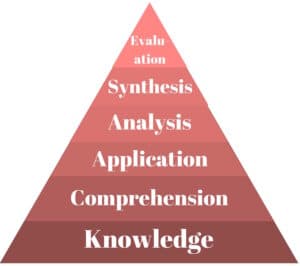
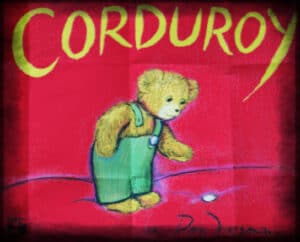
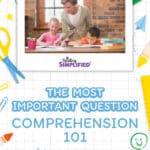

Children want to tell every detail of the story.
Yes, that’s so common, Brenda! They need coaching on how to identify just the gist. But that work of determining the most important and culling away the excess is great cognitive exercise.
I’d LOVE a bookmark with this info!
Hi Jayne, please email Kaylah at admin@readingsimplified.com and she will send that bookmark to you!
Very helpful, would like a bookmark
You bet! Kaylah will email that to you!
Thank you for the information. I would like a bookmark.
Great! Kaylah will email that to you.
Thank you for this post! I teach 3 hr/day kindergarten and am so rushed I’ve forgotten how important this is!
You’re welcome Diana! That is a short day to squeeze everything you probably want to squeeze in!! :O
Thank you for this enlightening and sensible breakdown of how we should focus on building comprehension in 3 steps. I am inspired to try this approach with my esl learners. I have experienced the lack of detail when children retell the story after listening to the story. I have asked questions that encourage them to remember the sequential aspects of the story eg. Beginning, middle and end. Whilst our verbal approach reminds them of the detail, their non verbal approach (written retell) lacks the detail. I must obviously rethink my teaching approach.
Thank you so much for taking the time to give feedback, Heather. It’s always so helpful as most don’t. Hope the simplicity streamlines things for you…
Thanks for sharing this! I’d appreciate a bookmark with these steps.
Thank you for sharing this information. I would like a bookmark.
Thanks for taking me back to the basics. I look forward to using the bookmark with my kids.
Teaching comprehension can be challenging, but this makes so much sense. Thank you for such a thorough explanation, along with the step-by-step coaching. I’ll be using this as the foundation for the compression piece during my guided reading groups.
Wonderful, Laura! So glad it makes sense and gives you a plan you like. 🙂 Thanks for letting us know.
This is great for me as a student teacher who is ready to go out on practicum. To guide me through the process .
Wonderful, Rose! What a great adventure you are embarking on as a student teacher! You can found out more about our core activities here: ReadingSimplified.com/start-here
I’d appreciate a bookmark.
Hi Janet! Not a problem! Be on the look out for an email from Kaylah.
Love how it’s all summed up on that handy little bookmark. I will be keeping it VERY close to me as it’s going to be my class August reading focus.
Absolutely, Rhonda! Be on the look out for an email from Kaylah!
This summer I have been trying to think through how to teach “retelling” or summarizing so that my students understand the story. These 3 parts seem so simple and yet I have not been focusing on them in this manner. I can’t wait to get my plans together to actually teach my students how to summarize a story. Thank you.
Wonderful, Lisa! Enjoy the rest of your summer, as well! 🙂
Thank you.
My pleasure!
It never ceases to amaze me how you make things so straight forward and simple. Can’t wait to try this three step framework with my next read aloud and guided reading groups. Thanks again
Thank you so much, Cathy! I look forward to hear how it works for you!
I want one.
Awesome! Kaylah will email it to you! 🙂
Thank you for simplifying how to get comprehension from my students. I think I will try this in other subjects as well. Thanks again, I have learned so much.
Renee, that’s so good to hear! That’s our mission. 🙂 Let us know what you find…
This was excellent Marnie!
So many of my tier 3 kiddos are just trying to read fluently. It is a great reminder to remember the purpose of reading is to comprehend the written message.
Brilliantly stated, Beth. Thanks so much!
I can’t wait to try this with my class! It makes so much sense!! Thank you!
Thanks so much, Missy!
These are wonderful tips! I would love a bookmark with this info.
Thanks, AnaLee! Keep an eye out for an email with your bookmark!
Thank you for this important reminder! Thank you for giving me affirmation that my first question is the best one for first graders – whether it’s, “Tell me what this story is about,” or “In your own words, tell me the important parts to this story,” or “Think about the beginning, the middle, and the end. Tell me what happened.”
Thank you so much, Tera! I hope these strategies serve you well!
This was so helpful! I’d like a bookmark please!
Wonderful! Keep an eye on your email inbox for the bookmark!
I would love a bookmark! This looks so helpful!
This is great. Thank you. I find children either want to give you every detail or hardly any at all. A book mark of this strategy would be very helpful.
So true Marita! We either have to pull it out of them or teach them how to pare it down.
Is there any chance of an online webinar focusing on Comprehension Skills?
Great request Marci! We haven’t focused on comprehension much because mainstream word reading instruction is so primed for massive improvements. But undoubtedly comprehension instruction is half of equation! We’ll keep it in mind.
Thanks, Marnie! This was a simplistic yet powerful strategy to build kids’ reading comprehension. I’m looking forward to trying it out! I would like a bookmark, please!
Thank you, Nancy! Keep an eye on your email for that bookmark!
This would be great for us to use in our fluency progress monitoring. We use Acadience and part of the ORF assessment is a retell. We can use these bookmarks to guide children to build this competency. Looking forward to receiving it 🙂
Great! Hope it does indeed serve you Emma. If you don’t receive the bookmark within about 10 minutes, check spam and/or gmail Promotions. If it’s not there, please email us at admin@readingsimplified.com
This is great for a fiction story. What is the process for an informational text for an older student?
Thank you. You’re right–I haven’t gotten to it yet. But Timothy Shanahan has written a good one:
https://shanahanonliteracy.com/blog/how-to-teach-summarizing-part-ii
Reading this comprehension blog has come at just the right time for me, reminding me of the strategies I need to use with one of my students who has great difficulty retelling and answering questions about the text he’s reading. I find he needs explicit teaching for everything he learns – but he’s so determined to get there that once he understands the lesson being taught, he applies it very well. Thanks Marnie – and I’d love a bookmark please to remind me as well!
Wonderful! 🙂
Hi Marnie, I do appreciate this 3-pronged approach to assessing the main idea of a story. I look forward to implementing it with my students.
May it serve your readers well!
This is so basic and yet so profound. With great pressure to focus on higher order thinking skills, my high school ELs are stuck at summarizing. I need to take the time to keep revisitng that.
Also, I think this explicit teaching of summarizing is best remembered as a summarize as you read approach, similar to blend as you read, with all of its cognitive processing perks. We are so beautifully made for this!
We are facilitating the layering of HOTS over summarizing skills, over blend as you read, over sound-symbol connectivity, in addition to increasing eyes on print time, and conversation turns, whether whole class, small group, or one-on-one; equipping students to respond and contribute to their world!
Clever! I love “Summarize As You Read.” Thanks for these wise comments Kelly.
This is so helpful, thanks! Summarizing is difficult to teach.
You’re welcome! Yes it can be challenging!